|
While visiting
the New Hampshire Ruger factory back last December, I was
there to look at and shoot their new LCR
.38 Special revolver, but while we were there, the Ruger
marketing and engineering folks also brought out a couple of
prototypes of their new semi-auto AR-15 style rifle, called the
SR-556. There were five writers there that day, and of course,
we were all sworn to secrecy. Ruger decided to introduce their
new rifle at the 2009 NRA Show in Phoenix, and my sample SR-556
arrived here just a few days before.
The AR-15 has been very popular with a lot of
shooters for many years now. The basic design is over fifty
years old, and selective-fire versions of the AR-15 have served
our military admirably for decades now. There are some folks who
seem to hate the design, blaming the rifle for failures more
related to the ammunition than the rifle design, but the fact is
the rifles work well when maintained well, and are relatively
light weight and easy to shoot. Anyway, the AR-15 is probably
the hottest-selling rifle in the United States right now, and
for good reason. I outlined in a piece titled “Homeland
Security” a few years ago why every American should own an
AR-15. It is important for every citizen to know how to properly
use and maintain our nation’s main battle rifle, and if it
ever comes down to it, spare parts and ammo are as close as your
local National Guard Armory. The outcome of our recent
Presidential election has spurred the biggest run on guns and
ammunition that our nation has ever seen. Even folks who voted
for Obama are now scurrying to buy firearms and ammunition while
they still can, taking him at his word that he wants to ban all
semi-automatic weapons from citizen’s hands. All over the
country, ammo and firearm sales figures are up dramatically,
especially semi-automatic rifles and pistols, and AR-15 sales
are leading the pack.
There are many brands of AR-15 style rifles
from which to choose, and most of them are pretty good. The
design is a solid one, well-proven, and most manufacturers do a
good job of putting them together. However, there are
differences, and a few makers produce a product that will
exhibit superior accuracy, or have a better trigger, or possess
other features that might endear a particular rifle to a
particular shooter.
Enter Sturm, Ruger, & Company with their
new SR-556. Ruger is not new to the semi-auto rifle market.
Their 10-22 is the most popular .22 Auto on the market. It is
light, reliable, affordable, and accurate. The Mini-14
design has been around for decades, along with the
selective-fire version of that rifle, the AC-556. Both are very
reliable weapons. However, there is no denying that the AR
platform is more popular these days, and Ruger has chosen the
ideal time to enter head first into that market. Not content to
just produce another “me too” AR-15,Ruger has taken the
time, money, and effort to produce what is in some ways a
superior product. I am not one who is constantly complaining
about the AR-15’s direct gas impingement system. It works
pretty darn well, and I have several ARs which perform
perfectly, and give me no problems at all. There are a few AR
manufacturers that have taken the basic AR-15 design, and
replaced the gas impingement system with a gas piston system.
Both systems work well, but Ruger has developed a gas piston
design that is very versatile, and should prove superior under
adverse conditions to both the gas impingement system and other
gas piston systems. The gas system on the SR-556 is adjustable.
There are four positions on the gas adjustment knob, numbered
from 0 to 3. The 0 position shuts off the gas that is bled from
the barrel to operate the action. In this position, the rifle
acts like a straight-pull bolt action, and the action must be
manually cycled. This is a good idea for training a new shooter
on the AR design, as the rifle will not self-load after each
shot. Also, if for whatever reason you do not want to leave a
piece of brass on the ground, you can set the knob to 0 and the
case will not be ejected. The standard position for most
ammunition with be the number 2 position. The numbers 1 and 3
positions have gas ports that are slightly smaller and slightly
larger than the number 2 position, respectively. The number 1
position is useful if the ammo is on the warm side, bleeding off
a bit less gas, and cycling more gently than the standard number
2 setting. If the weapon has become dirty from shooting, or from
blowing silt and sand, or if a batch of weak ammo is
encountered, the number 3 position will bleed off a bit more gas
to operate the action with more authority. This system reminds
me of the adjustable gas system on the legendary FAL rifles,
which have served all over the world, and are still in service
by some military units. In practical terms for the average
shooter, the adjustable gas system on the SR-556 allows the
shooter to adjust the system to perfectly suit the ammunition
being used. Setting the adjustment to the number 1 setting
allows for a “softer” function of the rifle, and should
reduce wear on the operating system. If a good deal is found on
some ammo that is not up to NATO specs, no problem. Just set the
adjustment to a higher number, and the rifle should function
reliably with the bargain ammo. In a more serious situation,
finding yourself with a filthy, dry weapon could get you killed.
Having an adjustment setting that will allow the rifle to
operate under adverse conditions might make the difference
between coming in first or second in a fight. The gas piston
system that Ruger uses is also very simple and easy to clean.
Rotating the adjustment to where the flat side is on top allows
the adjustment knob and piston to be pulled out. It can be done
without tools, or by using a cartridge or other tool to rotate
the knob. The piston is a two-piece design, and is about as
simple as such a thing can be. There are no small parts to lose,
and the rest of the disassembly for maintenance is like any
other AR, also very simple. I like simple.
Other features of the SR-556 make the rifle
more user-friendly. There are several inches of
Picatinny-compatible rail for attaching optical sights, bipods,
flashlights, lasers, forward grips, or any of the other
multitude of AR accessories available on the market. The Troy
Industries rails and hand protecting rail covers work very well,
and are also very good-looking features of the SR-556. The rifle
is equipped with superb folding sights, also manufactured by
Troy Industries. The rear is adjustable for windage correction,
and has two apertures for close and medium ranges, and the front
folding unit is adjustable for elevation correction. Both sights
fold down with a push of a button, and flip up instantly when
needed. The full-length top rail accommodates just about any
optical sight imaginable, such as the excellent Trijicon
Reflex shown here. I absolutely love the Reflex, and this
new one is much improved over the original. The new Reflex has a
tritium dot that is always “on” and never needs batteries,
like the original, but the new design uses a fiber optic
illuminator to brighten the dot as available light increases.
This allows the dot to be dim enough that it is not blinding in
low light, but the illuminator brightens the dot brilliantly for
use even in bright sunlight. Perfect.
The SR-556 wears a hammer-forged sixteen and
one-eighth inch barrel, and the muzzle wears an AC-556 flash
suppressor, which has proven to be very effective for many
years. Good choice. The Troy Industries Quad Rail handguard is
pinned to the upper receiver, and serves as a rigid guide for
the gas piston. The SR-556 wears a six-position AR buttstock,
which is an excellent choice, making the weapon very versatile,
and able to fit shooters of all sizes, and allows easy
adjustment for compact storage, or for use in tight quarters.
Since this question is bound to be asked, yes, the SR-556 fires
both 5.56x45mm NATO and .223 Remington ammunition, and I fired
the weapon with both, using a wide variety of bullet types and
brands. As many types as I had available, I fired for function
testing, and fired several of those for accuracy testing also.
The SR-556 weighs in at seven pounds, fifteen ounces empty, and
is soft on the shoulder, even for a 5.56/.223 rifle.
For accuracy testing, I mounted my Leupold
Mark 4 8.5 to 25 power scope, as this baby allows me to see just
how accurate a rifle can be. Optical clarity and target
definition is outstanding using this scope, and since I am far
from being an expert shooter, I like all the help that I can
get. The goal is not to see how well I can shoot, but to show
the accuracy potential of the subject rifle. I fired for groups
at 100 yards, and every brand tested displayed very good
accuracy from the SR-556. The barrel has a one-in-nine inch
rifling twist, and all bullets exhibited perfect stability, even
the long seventy-five grain boat-tail bullet used in the Wolf
Gold Match ammo. I fired for velocity readings with the
chronograph set at twelve feet from the muzzle. Velocities are
listed in the chart below in feet-per-second (fps), and all
loads were fired at an elevation of approximately 400 feet above
sea level, with an air temperature of around seventy-three
degrees Fahrenheit, with low humidity. Bullet weights are listed
in grains. FMJ is full metal jacket. SP is a soft point jacketed
bullet. The Extreme Shock loads are specialty ammunition, made
for extreme performance upon impact. The Extreme Shock 100 grain
load is a low-velocity specialty heavy bullet round that did not
prove suitable for this rifle, or any other 5.56mm/.223 that has
a standard length throat. It is listed for information purposes
only. As I have had this rifle only a short time, no attempt was
made to develop handloads for the weapon. I just grabbed what I
had on the shelf and went to work. However, I did send a lot of
lead down range through this SR-556, and accuracy improved as
the barrel seasoned from shooting. Accuracy readings are for
three-shot groups, fired from a Target
Shooting, Inc. Model 1000 rifle rest, and are listed in
inches.
| Ammunition |
Velocity |
Group Size |
| Winchester USA 62 FMJ |
2879 |
1.375 |
| Winchester USA 55 FMJ |
2858 |
1.75 |
| Extreme Shock 62 FHVL |
2712 |
1.75 |
| Extreme Shock 55 SRT |
2453 |
1.18 |
| Extreme Shock 100 ASP |
1071 |
Not Tested |
| Black Hills 55 SP |
2901 |
0.75 |
| Wolf Gold Match 75 BTHP |
2495 |
0.875 |
| Mag Tech 55 FMJ |
2909 |
1.18 |
| Buffalo Bore 69 Sierra |
2839 |
0.675 |
I was both pleased and surprised by the
accuracy displayed by the SR-556. The rifle has a chrome-lined
bore, and a standard AR trigger, both of which are usually not
conducive to the best accuracy from the bench, but every load
fired for accuracy in this rifle performed very well. While the
SR-556 is built to be a fighting rifle, it has plenty of
accuracy for competition or hunting. I continue to be pleased by
the performance of the Wolf Gold Match ammo, and intend to take
that ammunition and the SR-556 to the NRA
Whittington Center near Raton, New Mexico later this month
for some long-range accuracy testing, as well as the superb
Buffalo Bore Sniper ammo. It has both high velocity and
phenomenal accuracy.
The Ruger SR-556 comes with a padded soft
carry case which has Velcro straps to secure the rifle inside,
along with magazine pouches inside to store two magazines, and
an extra pouch on the outside as well. The SR-556 is supplied
with an instruction manual, padlock, and comes with three Magpul
PMAG thirty-round magazines. Of course, the SR-556 can use any
standard AR magazine, from the handy twenty-round Vietnam era
surplus magazines which are my favorite, to the 100 round Beta
C-Mag.
I am expected by some readers to be
impartial, and to an extent, I am. If I have a problem with a
weapon, I will always report it. However, while the market is
flush with excellent AR style rifles, I am really excited about
this one. I don’t know exactly why, I just am. I really like
this SR-556, and I like the folks that are responsible for
building it. From the CEO, to the marketing folks, to the
engineers, to the men and women on the production floor,
everyone that I have met at Ruger seems intent upon building
quality products that shooters want. The SR-556 is an AR in a
sea of many, but it has enough unique features to set it apart
from the ordinary, and it should prove to be another instant hit
for Ruger. Like all Ruger firearms, it is built in the USA.
Check out the full line of Ruger products
here.
For the location of a Ruger dealer near you,
click on the DEALER FINDER at www.lipseys.com.
To order the SR-556 online, go to www.galleryofguns.com.
For a closer look at the Leupold and Trijicon
optics shown here, go to www.leupold.com
and www.trijicon.com.
Jeff
Quinn
| For a list of dealers where you can
buy this gun, go to: |
|
To buy this gun online, go to: |
 |
|
 |
|
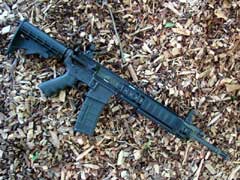


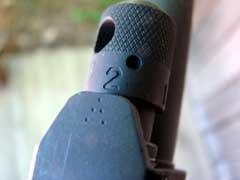

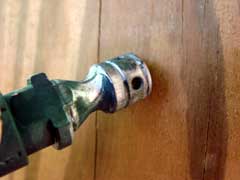
Adjustable gas piston design is simple and reliable.


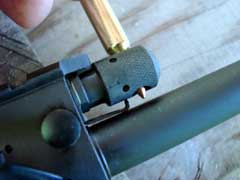
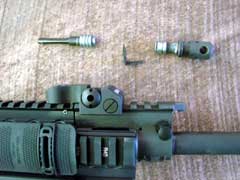
Gas piston is easily removed for cleaning.
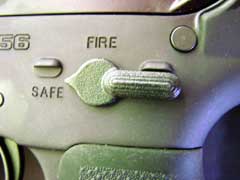

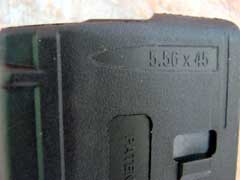
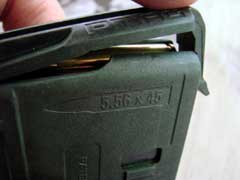
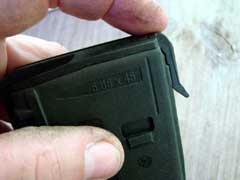

The SR-556 comes with three thirty-round Magpul
magazines.

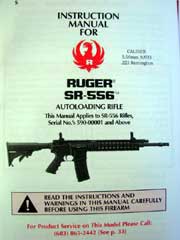
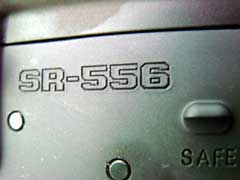
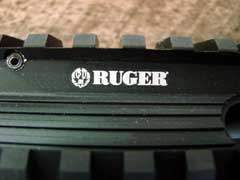
|
  
Got something to say about this article?
Want to agree (or disagree) with it? Click the following link to
go to the GUNBlast Feedback Page.
|
|
Click pictures for a larger version.
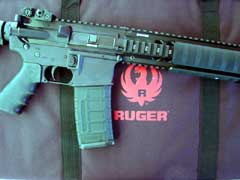
Ruger SR-556 AR-15 style 5.56mm semi-auto carbine.
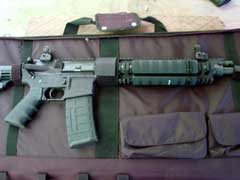
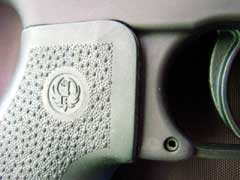
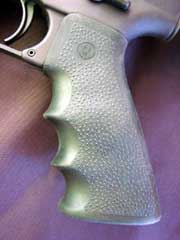
Pistol grip is a comfortable Hogue unit.
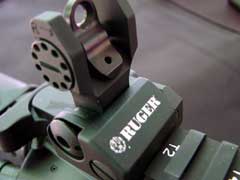
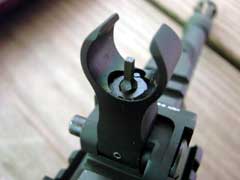
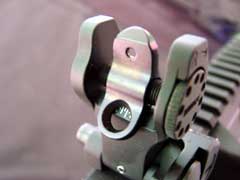

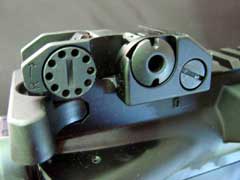
The SR-556 features Troy Industries' excellent
folding battle sights.
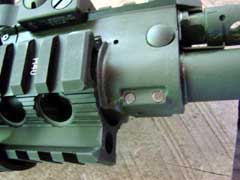
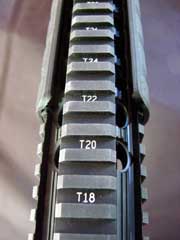
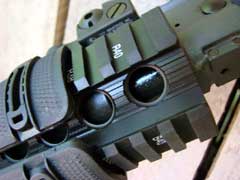
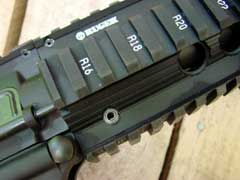
There is plenty of Picatinny rail for mounting sights
and accessories.
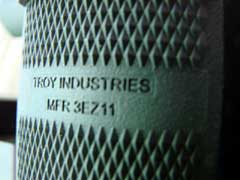
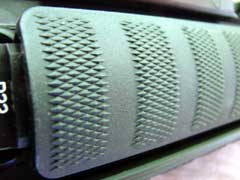

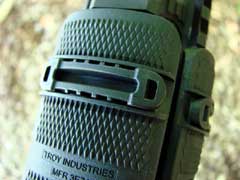
Rail covers protect the hand, and offer a comfortable
hold on the weapon.

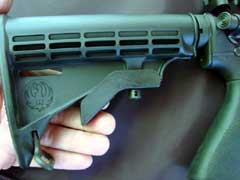
Buttstock is six-position adjustable.
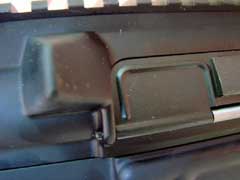
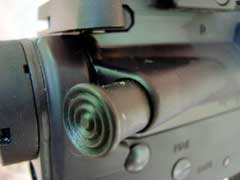
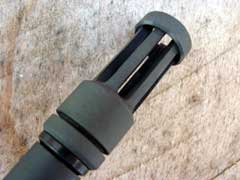
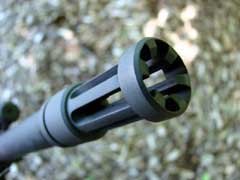
The SR-556 uses the proven AC-556 flash suppressor.
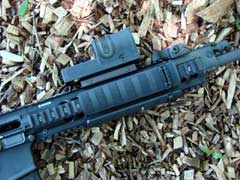



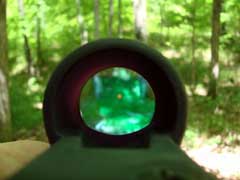
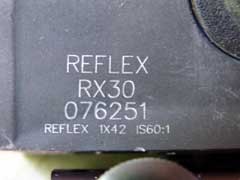


Trijicon Reflex sight.
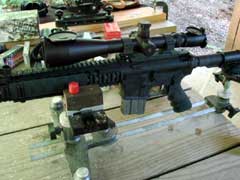
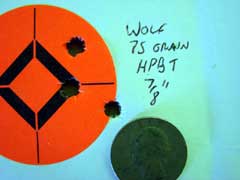
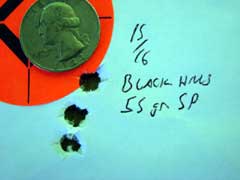
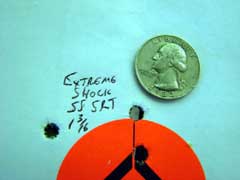
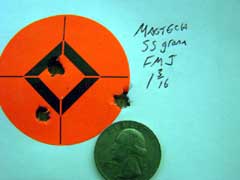
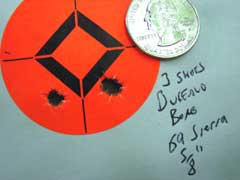
The SR-556 proved to be very accurate and 100%
reliable with a wide variety of ammunition.
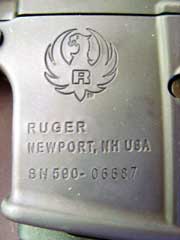
|
![]()